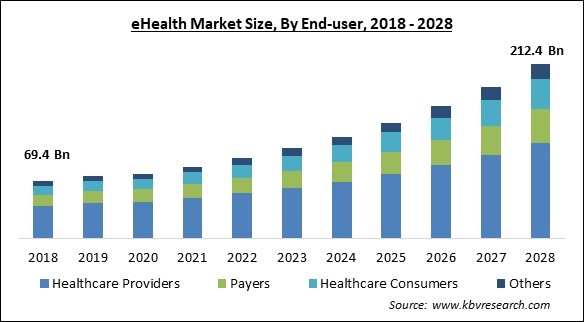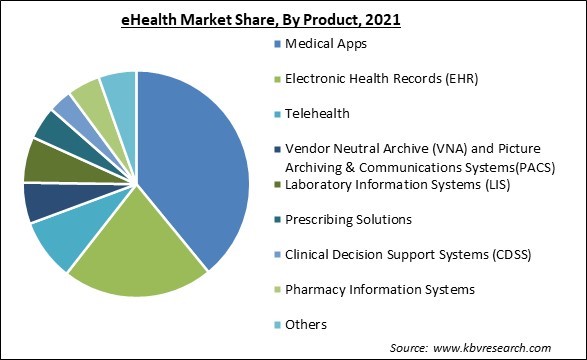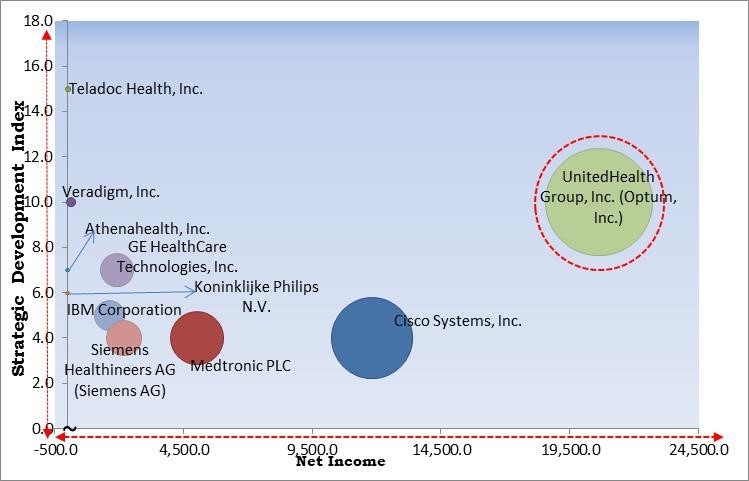The Global eHealth Market size is expected to reach $212.4 billion by 2028, rising at a market growth of 13.9% CAGR during the forecast period.
The application of information & communication technology (ICT) for health is known as "eHealth" widely. Medical apps, health records, and telemedicine have all used ICT extensively. E-health allows it to keep hospital patient, employee, and financial data online. The process of keeping healthcare data has changed as a result of this. The medical team initially entered data manually. Contrarily, all patient data is currently accessible in seconds, and only a single unique identification number is needed.

eHealth has several advantages over traditional clinical data management techniques, including eliminating manual record-keeping and facilitating quick access to patient information. Additionally, it is projected that automated & interoperable healthcare information systems would optimize payment for ambulatory and inpatient healthcare providers while enhancing patient happiness, lowering healthcare costs, increasing efficiency, reducing mistakes, and improving medical care.
The main factors driving the eHealth market are the expansion of government programs promoting the use of e-health products and services, the rise in the demand for e-health solutions to manage regulatory compliance, and the shortage of healthcare workers. In contrast, more prospects in developing countries, the growth of the mHealth, telehealth, and remote patient monitoring sectors, and an increase in the adoption of e-health solutions in outpatient care facilities are anticipated to offer attractive growth opportunities for the market.
The eHealth market is being driven by ongoing improvements in mobile technology, which are assisting in spreading eHealth programs. The ability to share information across various places is made feasible by telehealth systems for healthcare practitioners. In addition, the usage of home telehealth solutions increased dramatically for IT organizations during the continuing COVID-19 pandemic. On the other hand, many governments have published telemedicine guidelines to address the requirements of remote, difficult-to-reach populations. As a result, the eHealth market is expected to increase during the forecast period.
E-health and telehealth will advance with information science, technology, medicine, and biotechnology advancements. As a result, patients and healthcare workers in the future will be much more accustomed to using cutting-edge equipment, services, and software. Also, it is becoming increasingly clear that eHealth allows healthcare professionals to improve health systems and convert them from "detect and treat" to "predict and prevent" models. As a result, activities using eHealth solutions are growing, becoming more prevalent in outpatient treatment, and are anticipated to present opportunities for the eHealth market.
Businesses in the eHealth market are enhancing the benefits of deep medical learning to anticipate individuals' risks of dementia and Parkinson's. Numerous businesses are gaining expertise in artificial medical intelligence (AI) that predicts likely patient disease patterns. Several researchers have launched research projects using medical AI to examine non-invasive interconnections between brain areas to identify mental diseases in patients at very early stages. Hence, IT businesses should engage with academics and innovators to minimize the necessity for surgical treatments in the early diagnosis of mental diseases. Possible innovations and technological advancements are predicted to support the growth of the eHealth market in the upcoming years.
Physicians are restricting to adopt these systems because of their complexity & lack of user-friendliness in modern healthcare IT systems. Several doctors believe that using healthcare Technology solutions hinders their ability to communicate with patients. Also, in remote locations, issues including a lack of internet technology and a dearth of professionals accessible to offer technical assistance are to blame for doctors' reluctance to utilize HCIT solutions. All of these elements are having a negative impact on how quickly healthcare businesses adopt eHealth technologies.
Based on product, the eHealth market is segmented into medical apps, electronic health records (HER), telehealth, vendor neutral archive (VNA) & picture archiving & communications systems (PACS), laboratory information systems (LIS), prescribing solutions, clinical decision support systems (CDSS), Pharmacy Information Systems, and others. In 2021, the medical apps segment held the highest revenue share in the eHealth market. This is ascribed to an increase in the demand for high-quality healthcare products and services, an increase in the acceptance of mHealth practices, a surge in need for better patient safety and care, and a rise in government efforts to advance e-health. Also, the rapid uptake of tablets, smartphones, and other handheld devices is fueling the market's expansion.
On the basis of end-user, the eHealth market is divided into healthcare providers, payers, healthcare consumers and others. The healthcare consumer segment covered a considerable revenue share in the eHealth market in 2021. The expansion of this segment may be attributed to a variety of developments, including the expansion of healthcare infrastructure in places like Asia-Pacific and the expansion of demands for healthcare cost-cutting measures. In addition, the segment's growth is further supported by the rise in chronic sickness cases and the demand for hospice care and round-the-clock monitoring systems.

| Report Attribute | Details |
|---|---|
| Market size value in 2021 | USD 87.1 Billion |
| Market size forecast in 2028 | USD 212.4 Billion |
| Base Year | 2021 |
| Historical Period | 2018 to 2020 |
| Forecast Period | 2022 to 2028 |
| Revenue Growth Rate | CAGR of 13.9% from 2022 to 2028 |
| Number of Pages | 240 |
| Number of Table | 333 |
| Report coverage | Market Trends, Revenue Estimation and Forecast, Segmentation Analysis, Regional and Country Breakdown, Competitive Landscape, Companies Strategic Developments, Company Profiling |
| Segments covered | Product, End-user, Region |
| Country scope | US, Canada, Mexico, Germany, UK, France, Russia, Spain, Italy, China, Japan, India, South Korea, Singapore, Malaysia, Brazil, Argentina, UAE, Saudi Arabia, South Africa, Nigeria |
| Growth Drivers |
|
| Restraints |
|
Region-wise, the eHealth market is analyzed across North America, Europe, Asia Pacific, and LAMEA. In 2021, the North America region dominated the eHealth market with the maximum revenue share. This is because there are many e-health businesses, good regulatory conditions for e-health, more people are adopting e-health solutions to reduce spiraling healthcare costs, regulatory requirements for patient safety, and many e-health businesses. The government in the region used a populace that is well-maintained digitally, the availability of supportive infrastructures, including high-speed internet, and other initiatives to fuel market expansion.
Free Valuable Insights: Global eHealth Market size to reach USD 212.4 Billion by 2028

The major strategies followed by the market participants are Partnerships. Based on the Analysis presented in the Cardinal matrix; UnitedHealth Group, Inc. (Optum, Inc.) are the forerunners in the eHealth Market. Companies such as Cisco Systems, Inc., GE HealthCare Technologies, Inc., and Medtronic PLC are some of the key innovators in eHealth Market.
The market research report covers the analysis of key stake holders of the market. Key companies profiled in the report include Medtronic PLC, IBM Corporation, Cisco Systems, Inc., GE HealthCare Technologies, Inc., Veradigm, Inc., Koninklijke Philips N.V., Siemens Healthineers AG (Siemens AG), Teladoc Health, Inc., UnitedHealth Group, Inc. (Optum, Inc.), and Athenahealth, Inc. (Veritas Capital).
By Product
By End User
By Geography
The global eHealth Market size is expected to reach $212.4 billion by 2028.
Surged use in outpatient care facilities are driving the market in coming years, however, Medical practitioners' reluctance to accept innovative eHealth solutions restraints the growth of the market.
Medtronic PLC, IBM Corporation, Cisco Systems, Inc., GE HealthCare Technologies, Inc., Veradigm, Inc., Koninklijke Philips N.V., Siemens Healthineers AG (Siemens AG), Teladoc Health, Inc., UnitedHealth Group, Inc. (Optum, Inc.), and Athenahealth, Inc. (Veritas Capital).
The Healthcare Consumers segment acquired maximum revenue share in the 2018 in 2021 thereby, achieving a market value of $36.5 billion by 2028.
The North America market dominated the Global eHealth Market by Region in 2021, and would continue to be a dominant market till 2028; thereby, achieving a market value of $73.8 billion by 2028.
Our team of dedicated experts can provide you with attractive expansion opportunities for your business.

